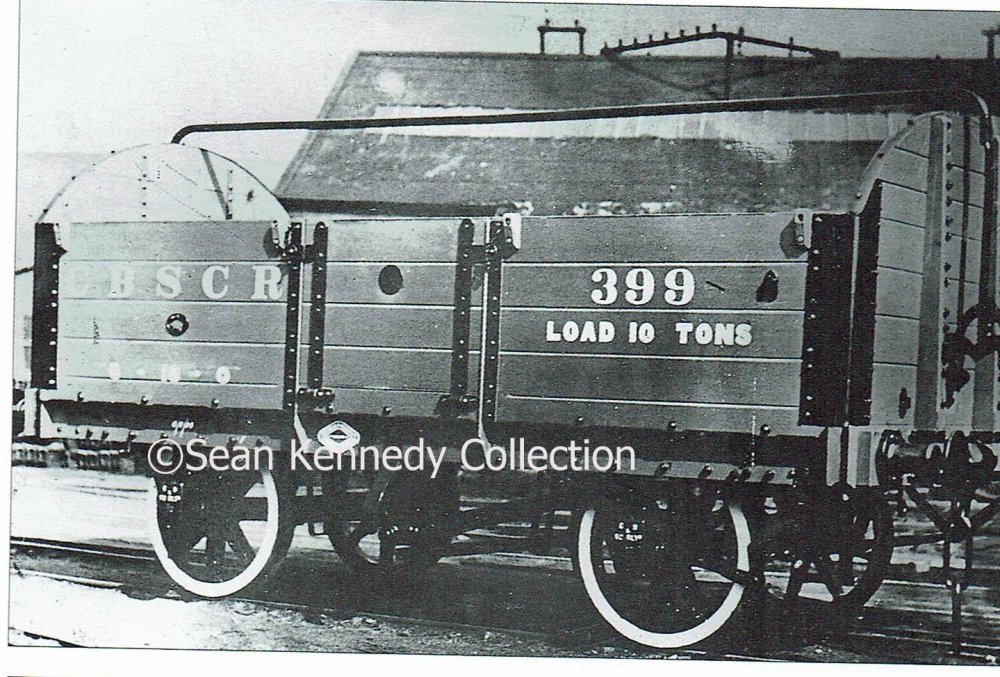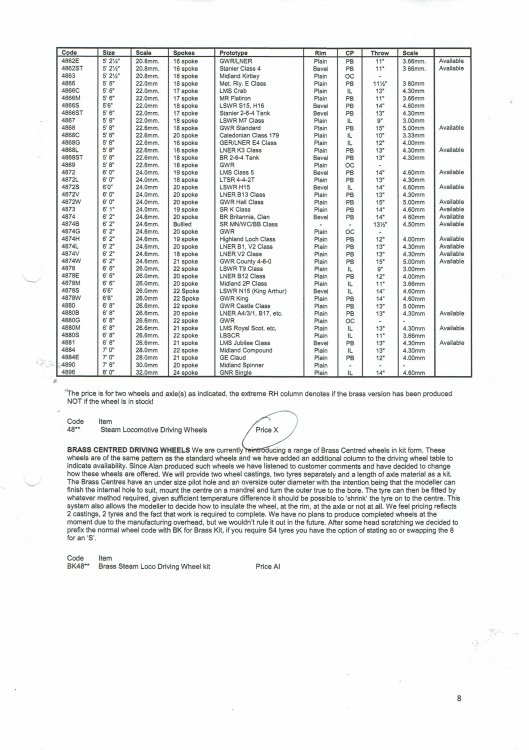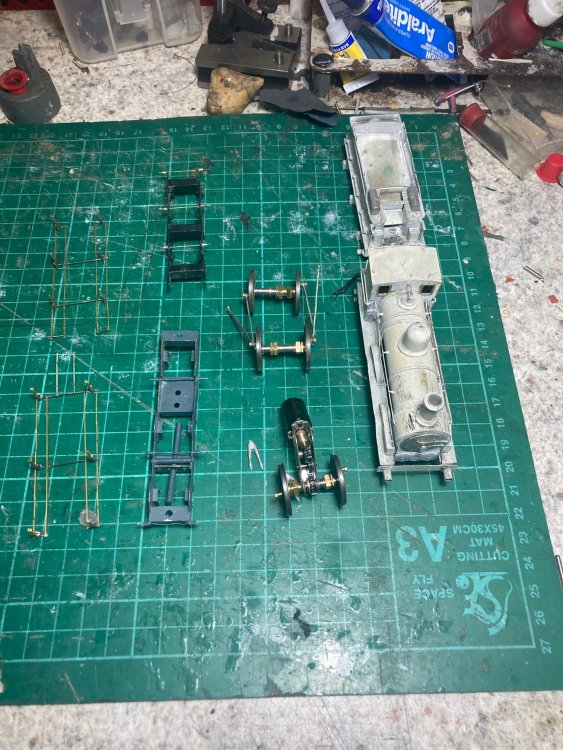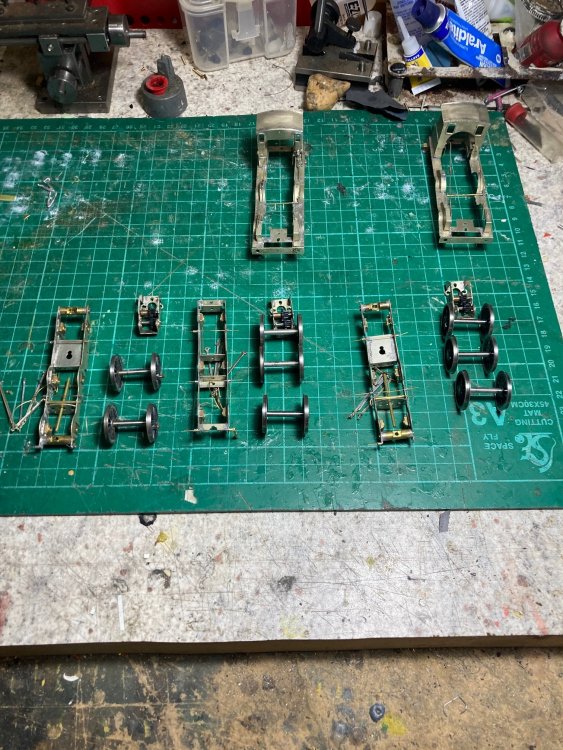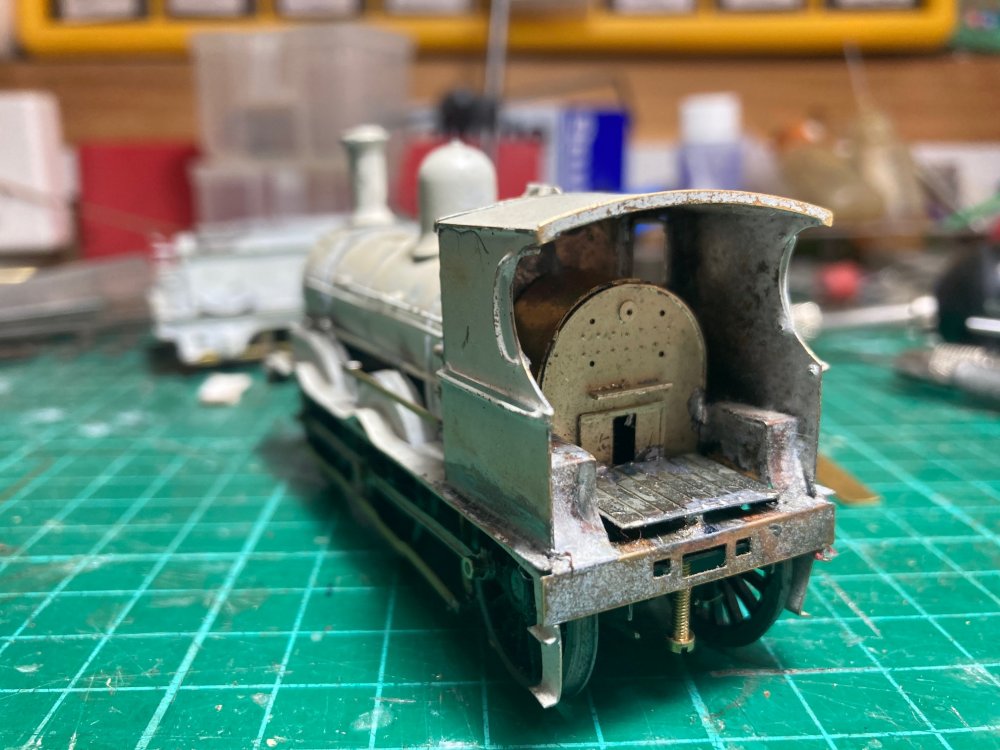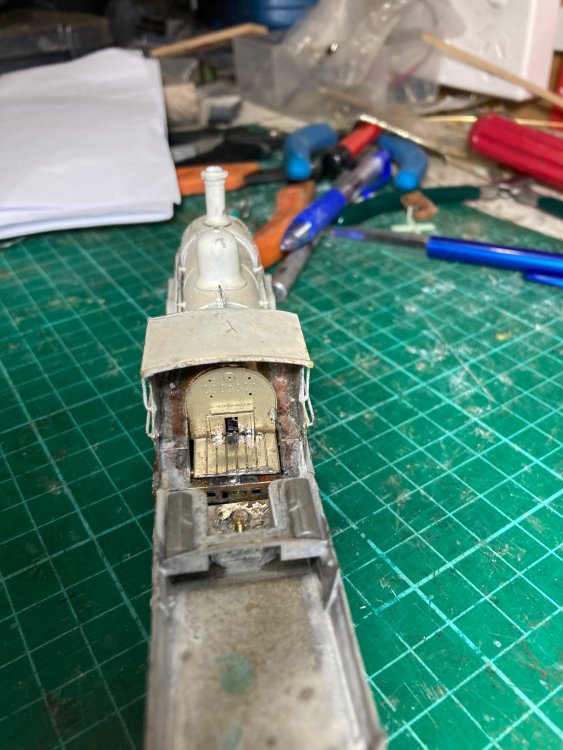-
Posts
4,875 -
Joined
-
Last visited
-
Days Won
119
Content Type
Profiles
Forums
Events
Gallery
Everything posted by Mayner
-
Interesting one A25 is fitted with deflectors apparently to reduce wind turbulence around the snatchers while exchanging ETS staff at speed. The coaches appear to be relatively new Laminates a large number of which (over 60) were introduced in 1958-59 and would have allowed reasonably uniform rakes to be made up for the Cork Expresses and other prestigious trains until they became due for heavy repairs. The leading coach is a 1909-1913 main line Brake Second a type that was usually marshalled at the South end of Main Line trains, presumably there is an older CIE "Bredin" style Buffet Car and a 1st Class Coach or Composite marshalled towards the rear of the train coupled to a 4w Heating and Luggage Van.
-
Courtaulds Carrickfergus, the four CSE Sugar Factories and the two NET/IFI fertiliser plants are probably the best examples of relatively modern large scale rail served manufacturing/process plants in Ireland. The main drawback in trying to model such large scale operations is the the sheer amount of space required to model either the marshalling yard or manufacturing/processing plant and limited operation potential compared to the more compact Victorian/Edwardian area operations such as Allman's Distillery in Bandon, and private sidings that served the milling industry and Ulster's Linen Industry. In its heyday in the era before Prohibition Allman's Distillery would have received coal and malt (bagged) in open wagons and sent out the finished product in covered tramway with "Pat" and its predecessor shunting wagons within the distillery and along the private siding tramway to the main line connection at Bandon Station. Similarly private sidings at stations such as Clara and Ballysodare generated a considerable volume of freight traffic, Clara was a particularly busy station in the wagon load era with private sidings serving Ranks Mill and the Goodbody textile factory which were shunted by a pilot loco (a G 601 in later years) that also worked the Banagher Goods The Goodbody mill received jute possibly in open wagons and dispatched the finished product in covered wagons. Ranks mill would have received grain in covered hoppers and possibly dispatched flour or animal feed in covered vans before the traffic was lost to rail. It could be argued that CIE lost a lot of traffic to road with its fixation with fixed formation Liner Trains in the 70s, with large shippers such as Bord na Mona, the Irish Sugar Company, Cadburys and grain millers shifting to road transport following the closure of the majority of private sidings in the 70s. Although the sugar company continued to be a major shipper rail was used mainly for long haul traffic from South Wexford to Thurles and later Mallow and between North Kerry and Dundalk/Navan to the Tuam Factory with Carlow the most productive plant served exclusively by road.
-
Beautiful render, the challenge is finding a printer (business or machine) with similar capabilities.
-
The Irish Beet Factories are likely to have been sugar refineries capable of processing sugar all year round rather than during the campaign. The beet would have been stored or processed to an intermediate stage for further processing at a later stage. This would have reduced plant, warehousing and inventory costs. Similar principals apply in the dairy and meat processing industries. https://en.wikipedia.org/wiki/Sugar_refinery Inward Traffic: 1. Coal: The CSE factories and Cement Limited both received Arigna coal by rail into the late 1950s 2. Lime: 3. Beet: Outward 1. Beet Pulp: Transported in H Vans good photos of H Vans in empty beet trains in Rails Through North Kerry. 2. Refined sugar retail and commercial quantities: H vans until replaced by road transport. Carlow Factory dispatched export sugar in 20X 8'6" container on 4w flat wagons in special trains during the early 70s, trains ran as out of gauge specials, containers loaded while on wagons in factory rather than Carlow goods yard.
-
At the time only one or two Bo Bos (not sure 141 or 181) were fitted to work the air braked LHB bogie cement wagons. The A Class were unable to haul the bogie cements as they were vacuum braked only, there was a rumour that some 001 Class were to be fitted using equipment salvaged from the B101 Sulzers an number of Sulzers were moved from the Sound Barrier into the Works for assessment. I sheltered from a sudden downpour in the engine room of B106 during a Works visit in the late 70s. Going back to Noels point on wagons the A and later 001 classed basically hauled everything that ran on the CIE/IE rail system apart from air braked stock such as the LHB Bulk Cement Wagons, Shale Wagons and MK3 coaching stock. Traditional freight (fitted and unfitted) rolling stock would have included anything that was capable of moving from their introduction in 1955 to the ending of loose coupled goods working in the mid 1980s (Sugar Beet, Dundalk-Adelaide freights, Civil Engineers), while most pre-amalgamation freight stock was out of service by 1960 some GSWR and GSR wagons (particularly vans and opens) continued in regular use into the early 1970s, some receiving the wheel logo and red oxide. GNR stock was added to the mix in 1958 although most opens and vans had gone by 1970s, the distinctive ex-GNR 16T bagged and bulk cement wagons built in the 1950s continued in service until replaced by the Pallet Cement Wagons in 76-77 and the final batch of Bubbles in the early 70s. Although CIE introduced the wheel logo in the early 1960s and began to paint wagons red oxide in the early 70s, wagons were only repainted when absolutely necessary (following overhaul, corrosion treatment or damage repair) and retained grey paint and sometimes 1950s snail logo and lettering until scrapped during the late 70s early 80s
-
The train is a real time capsule from the late 1950s with no two vehicles alike The first coach appears to be an ex-GSWR clerestory coach dating from the early 1900s. The second coach appears to be a Bredin Corridor Second dating from the mid 1930s. The third vehicle appears to be a Bulleid 4w Luggage Van or "Hooded Van which were introduced in 1956/7. The Wexford-Rosslare local trains continued to be steam worked into the late 1950s. There is a series of photos of the 6:50 am Wexford_Rosslare at Rosslare Harbour in Anthony Burges "Chasing the Flying Snail" The train which was hauled by ex-GSWR D10 4-4-0 314 was made up of an ex-GSWR Clerestory, an ex-MGWR 6w coach and a Hooded van. The train returned as a mixed (goods and passenger) to Ballygeary with the loco running tender first with the wagons coupled between the loco and the coaches.
- 1 reply
-
- 3
-

-

-

-
Well I left everything on the workbench for a week and no long lost parts turned up, I better put them back in the scrap box for another year or so. The white engine is now another grey engine. I washed the loco and tender in hot water followed by a good scrub with an old tooth brush & washing powder to remove any residual flux and 10-15 year grime and gave the loco & tender body a mist coat of grey aerosol etch primer. Luckily the etch primer did not react with the existing white primer. A some sanding followed by a second coat of primer disguised most of the blemishes. It looks like the loco will be in late GSR early CIE condition with hungry boards on the tender modeled from ply sleeper strip to be followed by another coat of primer and GSR grey enamel. I removed the driving splashers from Coey J15 229 as there was insufficient clearance between the driving wheels and splashers when I test fitted the wheel sets. The Alan Gibson wheels which I am using in the two new locos are approx. 0.24mm wider than the Sharman wheels which I fitted to my older J15s. The problem arose because I did not remove the temporary splasher sides that are used to align and support the footplate while fitting the valences and forming the curved running board. I am using a piece of hardwood to support the running board when I replace the splashers. The valences and running board were assembled with a higher temperature (179) solder than that used in the general assembly of the loco to minimise the risk of parts falling off during final assembly.
-
I will send you a copy of the SSM/TMD instructions, the kit was originally produced by TMD (Terry McDermott) in 1985. It also looks like the 2mm J15 fret includes a chassis for a GNR(I) 4-4-2T which could possibly be used under one of the small wheeled GNR 4-4-0s bought by the SLNCR during the 1920s.
-
There is a brief history and a number of photos of CBSCR open wagons in Ernie Shepherd's CBSCR book. The model appears to be based on the 10T opens built by the railway and bought from Pickering in the early 1900s. The wagons appear to have been intended for grain traffic and at least one of the Pickering wagons fitted with a tarpaulin bar and raised ends. Some CBSCR wagons were fitted with Dean-Churchward brake gear which would be challenging to model in 2mm scale. Makers photo of 399 possibly in red with blackened ironwork. There is an in-service photo of CBSCR open 603 in allover grey with white lettering and numerals in Ernies Shepherd's book, the wagon appears to be to the same design as 399 but with the exception of raised ends and sheet rail. Most British builders works photos of Irish wagons have blackened ironwork. Its possible the ironwork was painted in black for advertising purposes, alternatively the ironwork may have been blackened before assembly to resist corrosion. https://en.wikipedia.org/wiki/Black_oxide#:~:text=Black oxide or blackening is,and to minimize light reflection.
-
I was a big fan of Tony Koester's Train of Though Column and modelling when I took up American modelling while living in the UK in the late 80s and quite disappointed when he abandoned the Allegheny Midland to model the Nickle Plate in the Mid West in 2000. I was attracted to mountain railroading in the Appalachians and started building a layout and even visited the railway in the area in the late 1990s before experiencing a similar epiphany when I visited family in the mid-West in the early 2000s. Although there had been a lot of rationalisation, similar operating conditions to the 1950s continued to exist in some of the grain growing areas of the Mid West with both Class 1 and Short Line railroads continuing to serve relatively small local industries (Grain Elevators, LPG depots, Ethanol Plants, Flour Mills) Class 1s continued to interchange with Short Lines by setting out and picking up cuts of cars at junctions. TWC (Track Warrant Control) had replace Telegraph and Train Order in Dark Territory full size railroads essentially adapting model railroad practice with the Dispatcher instructing the Engineer directly by 2 way radio rather than through a local Operator or Agent (equivalent to a porter/signalman in Ireland or UK) Although my small scale American modelling has been on the back burner for several years, I have a collection of typical Mid-Western grain elevators and some grain cars if I ever get the urge, time or space to build an American small scale layout. While the sheer scale of an American Basement empire is out of reach of many modellers some of the design principals for a prairie railroad the use of backscenes and narrow baseboards between linking sections are equally applicable in an Irish context particularly for modelling a the MGWR & GSWR lines that cross the Central Plain and Bog of Allen. The American style operating layout with formal operating sessions with multiple operators was once common in the UK and Ireland, with layouts like Sam Carse's Donegal, Drew Donaldson's CIE layout and Norman Eagles Sherwood Section of the LMS, now appear to be very rare with fewer people apparently having space for a large layout and the focus on building exhibition layouts.
- 1 reply
-
- 1
-

-
Some really inspiring Irish Narrow Gauge modelling https://get.google.com/albumarchive/112461785190797901174/album/AF1QipOlcL7V3TY1kIN0Paiy7bNdnSZH5qarJor-vWNj. an excellent resource and source of encouragement. George Hannan modelled the Irish narrow gauge in both 5.5 and 4mm scale and the Welsh Narrow gauge in 009. Most of his locos appear to have had scratch built mechanisms. There was an article on his Killybegs layout in the Railway Modeller during the early 1960s. He showed me scratchbuilt 4mm models of a T&D Hunslet Tank and some of his Welsh narrow gauge models (complete with outside frames and cranks) during visits to his Malahide Art and Model shop during the late 1970s. He also built a OO9 layout with very realistic North Wales scenery, buildings and structures, probably one of the best of the "rabbit layout" genre of the 60s and 70s
-
Have you thought of using 5.5mm Scale on OO track rather than OOn3 for modelling the Irish 3' gauge? This scale gauge combination was used by Sam Carse in his Donegal Railway layout and by other modellers for modelling the Irish 3' before TT gauge was introduced in the 60s. 5.5mm has the advantage that you would be able to use reasonably in-expensive and reliable Hornby 0-4-0, 0-6-0, wagon chassis and bogies in your models, while developing the skill and experience to assemble a loco with outside cylinders, cranks and valve gear, you already seem to have cracked it in terms of 3D modelling.
-

Would you model in 21mm if RTR track and models were readily available?
Mayner replied to BosKonay's topic in Irish Models
There is a real danger of achieving very little by over estimating the difficulties (paralysis by analysis) as opposed to practical experimentation. Before the days of Murphy Models Bo Bos I simply assembled and mounted MIR 121 & 141 Class locos on re-gauged Athearn blue box SW1500 chassis having pushed out the stock Athearn wheels to run on 21mm gauge. Its simple enough to re-gauge the Murphy models diesels by fitting the existing wheels and gears to 26X2mm plain ended axles or ordering 21mm gauge wheelsets from Ultrascale if you work to EMF or S4 standards(expensive but worth the wait). 21mm steam locos are not for the novice loco builder or basher. My Ruston DS88 (Impetus kit) was originally built to OO and later re-gauged to 21mm by replacing the axles, I need to replace the wheels some day as they are S Scale wagon wheels. My first successful 21mm gauge coaches used fairly crude conversions of Hornby and Lima bogies, I made extended axles by cutting and sleeving standard 26mm OO gauge axles. Although the conversion was crude these bogies ran smoothly and regularly operated on the MRSI Loughrea layout. Converting rtr freight stock was not an issue as nothing suitable was available before IRM came on the scene all my (30+) wagons were assembled from kits or scratch built. Wagons such as the Parkside BR Plywood van or Airfix/Dapol tank wagon were converted to Irish wagons by modifying the bodies and moving out the solebars and fitting wheels with extended axles. Hand laid track with copper clad sleepers is a inexpensive and reasonably fast way of laying track and a lot easier to ballast than Peco, hand laid track with rail spiked to strip wood sleepers is popular in the United States and used on many of the Basement Empire Layouts such as Tony Kosters "Allegheny Midland". Most of the Irish Broad gauge (7 & 4mm) exhibition layouts were club or group efforts with the notable exception of David and Andy on this board. Loughrea and Belturbet were both club layouts while both while Tony Miles Adavoyle layouts and Richard Chowns Castlerackrent were very much group efforts. Tony both developed his own finescale 4mm standard and pioneered 21mm gauge modelling, Richard Chown pioneered Irish Broad Gauge modelling in 7mm and Castle Rackrent developed into a large modular system layout with several stations. The choice between OO and 21mm gauge or rtr and kit/scratchbuilding basically comes down to how you prefer to spend your modelling time, type of layout and available space. If you want to get something up and running quickly or build a large complex layout OO is the obvious choice, 21mm is more appealing to people who prefer to spend their time building layouts and models. The type of layout and space largely determines the track and wheel standard as a 21mm continuous run layout built to EMF standards (wheel and running clearances) will occupy a larger space than an equivalent OO gauge layout. A 21mm continuous run layout to S4 standards will occupy a larger space than an equivalent layout built to EMF standards. It will probably be necessary to reduce the gauge below 21mm if OO gauge wheel and running clearances are adapted to allow similar minimum radius curves to OO gauge. -
There is insufficient interest to proceed with the signal box kit within the £45-50 price range. If anyone is interested we can supply the signal box to order direct from York Model Making at £75 including postage. The kits are laser cut from 1.2mm MDF and Rowmark plastic parts and include York Modelmaking slates and ridge tile sheets. The corners of the MDF brick panels will need to be mitred.
-
Listing a building without assisting its restoration/maintenance can impose an unreasonable burden on the owner or occupier. One of the best examples was the designation of the East Broad Top Railroad in Pennsylvania as a National Monument in 1964 deprived the owners (a scrap metal company) of an income from scrapping/disposing of the line until 2020 when a not for profit foundation bought the railroad and its assets.
-
A 1970-80s Irish construction collection 3 axle Hino mixer, tipper and block truck with Hiab Grab, possibly a generic chassis and body with the option of Hino, Ford D or even Volvo cabs. One Roadstone owner driver in the late 70s invested in a Volvo for hauling stone from Belgard & De Selby while his colleagues bought Ford and Hino Roadstone operated all three types nationwide, Readymix concrete and blocks plus regional companies and a lot of unbranded owner driver tippers hauling for the major suppliers, earthmoving contractors and on their own account. Irish concrete mixer trucks were usually fitted with higher capacity bottles than similar vehicles in the UK, similarly tipper trucks were fitted with high capacity bodies (Thompson Carlow?) which were quite different in design and appearance to the UK.
-
There is an extract from a 1960s Railway Modeller article on the A Class in the archives section of this board. It might be worth while contacting Iarnrod Eireann or the IRRS to check whether copies of the original Metropolitan Vickers drawings & details of CIE modifications are available.
-
It looks like the loco may have been supplied with a set of plain driving wheels and outside cranks intended for a GWR outside frame 4-4-0. There is a 4880G 6'8" spoke outside crank driving wheel listed in the Alan Gibson catalog with are used with the 5000 outside cranks and extended axle. The driving wheels listed OC are for outside framed locos, the outside cranks and extended axles are supplied as a separate part
-
The realities of operating a heritage railway in 2021 It looks like the company that operates the 8 mile long Llangollen Railway had to cease trading and call in the administrators https://www.leaderlive.co.uk/news/19235853.llangollen-railway-administrators-advanced-negotiations-potential-buyer/
-
"White Engine" dismantled for cleaning and painting showing brake gear sub assemblies. Next job was to sort out the parts for the other 2-3? members of the class. I originally bought two J15 kits in 2007-8 complete with wheels gears and motors as it seemed to be a good idea at the time, then designed a set of frames for a superheated loco. The idea was to scrap the chassis from my original 1986 J15 193 and re-use 193s wheels in one of the new chassis, somehow or other I ended up with an additional pair of 21mm gauge wheelsets that I have no recollection of buying or setting up for 21mm gauge, fitting crankpins and painting!. I seem to have used one of the motors to motorise a J16, but luckily enough did not loose any of the gearbox parts, coupling rods or bearings since I assembled the chassis 3 years ago. The Alan Gibson wheels have plastic (nylon?) centers which are a push fit on 1/8" dia axles, in this case the 21mm gauge axles were cut slightly over length from 1/8" silver steel and finished in the Unimat. Next job will be to assemble the brake gear, I will probably make up a jig for assembling the pull rods and stretcher bars to achieve greater consistency than assembling the gear on the individual chassis. The main hurdle to completing the locos at this stage is difficulty in obtaining suitable motors as one of the main Uk suppliers is furloughed as a result of Covid restrictions.
-
Interesting Bell labeled Seddon Atkinson Tug unit and drawbar trailer combination presumably used for traffic between Tee Port and ICI Wilton, good example of the scale and nature of Bell's UK operations. Bell Containers used to show up regularly at Willesden Freight Liner Terminal after the opening of the Channel presumably transporting traffic between the Uk & Continental Europe
-
A high proportion of the UK small supplier sales are through the large UK exhibitions, specialist societies and advertising in model railway magazines rather than impulse buying on the internet. Its likely that Alphagraphics and other specialist O Gauge suppliers are catering to a demographic group who prefer and are prepared to pay for a printed catalogue that also acts as a reference than look something up on the web. The main challenge for these suppliers at the moment is keeping up with demand as more people are turning to modelling as a result of Covid restrictions in the UK.
-
A bit more work on the "White Engine" mainly completing detailing and fitting the loco tender drawbar. I thought I had mislaid the smokebox door and ended up fitting one of my own GSR style doors complete with hand wheel before finding the original in the scrap box, one of the next big jobs (after painting) is finding the bufferheads and fitting the front 3 link coupling . I used some suitable riveted strapping from the scrap box to represent the riveted strip between cab side and running board a distinctive feature of these locos, the original strapping was still in place on the fireman's side. Although its difficult to see I fabricated and fitted the loco-tender drawbar from an offcut of PCB sleeper strip. The cab interior involved some skulldugery. The splasher tops/seats are part of the original model, the backhead from another J 15 kit and the cab floor from a MGWR 2-4-0. I used a piece of scrap brass to replace the section of firebox that had been cut away/removed during the assembly of the original model. Next stage will be to dismantle the loco and tender to its component sub assemblies to prepare for painting. Interestingly I 'found" another Mashima 10X20 motor in the J 15 parts box to complete the assembly of the "Coey" J15 .
-
Its probably best to contact N-Drive Productions directly about their plans for the Backwoods Miniatures CDR & Irish 3' gauge models. The kits were designed in the early 90s and some re-design and new tooling may be required as some of the parts used to motorise the models (wheels, gears and motors) may no longer be available. While the standard of the castings and etched parts was quite good with parts fitting accurately using slot and tab construction, the locos and railcars were challenging to motorise mainly because few suitable components were available for OO9 and 12mm Gauge which my no longer be an issue if N-Drive develop suitable 12mm chassis. I have no direct experience of assembling a Backwoods Miniatures CDR loco, but I assembled one of the CDR articulated railcars, a pair of C&L 4-4-0T and several C&L wagons. The railcar was a smooth and reliable runner while I both C&L 4-4-0Ts required considerable work including new gearboxes and bogie modification to achieve reliable running.
-
On a more prosaic scale the Irish Government chartered a train to transport milk powder from Cork to Dublin when Dublin was "cut off" from the rest of the country by a blizzard during the early 80s. The main roads to the South and West were blocked by a blizzard and heavy snowfall in January 81 or 82 though CIE managed to keep the Cork line open. There was almost panic buying of food in Dublin with supplies from the rest of the country cut off. The milk powder appears to have been transported in two parcel vans rather than a Liner, things got back to normal within a week as roads were cleared/snow melted.
- 1 reply
-
- 1
-

.png.c363cdf5c3fb7955cd92a55eb6dbbae0.png)


